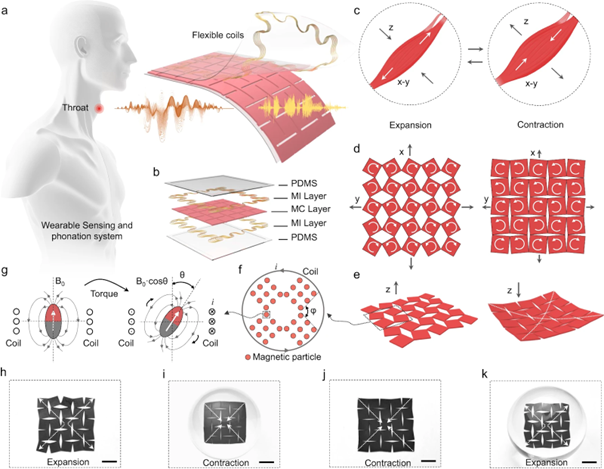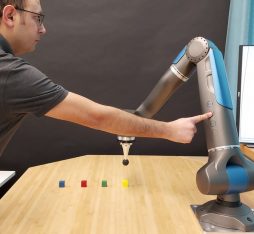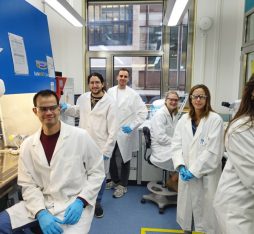• The light and flexible device, which is worn on the throat, converts laryngeal muscle movement into electrical signals with a sensor design inspired by the art of kirigami (a Japanese modelling technique that uses a single incised sheet of paper), which enables patients to communicate when, for example, they are recovering from treatment for voice disorders.
• Assisted by a machine learning algorithm, the device, which provides an adaptive and customizable solution for individual users, can extract more than 94% of the semantic content from signals derived from movement on patients’ throats.
Is it possible for patients who have lost full use of their vocal cords to recover the power of speech? A research team from the University of California in Los Angeles (UCLA) is developing a soft robotics device that can overcome the isolation caused by aphonia to bring voices back to life. “There is a pressing need to develop a wearable, non-invasive medical device capable of assisting patients in communicating during the pre- and post-treatment recovery of voice disorders,” point out the researchers in an recently published article in Nature Communications. Vocal cord issues are also a common cause of partial loss of speech or dysphonia, which affects many patients who face a long and painful convalescence in the wake of surgery. Although devices such as electrolarynxes are available, voice disorder sufferers often complain that they are uncomfortable and difficult to use.
Using a machine learning algorithm, the device semantical meaning of the signal and select a corresponding voice signal for output
Jun Chen, one of the researchers behind the innovation, explains how it works: “The concept is for a wearable placed on the throat that uses magnetoelastic actuation to produce sound without vocal cords.” Magnetoelasticity is a phenomenon in which a material’s magnetic properties change under mechanical stress, in this case caused by the vibration of the patient’s throat. With assistance from a machine learning algorithm, the device can classify semantical meaning in muscle movement and convert it into speech signals with an accuracy of more than 94%.
A multi-layered system
Weighing only eight grams, the self-powered and self-adhesive device, which is attached to the throat, is equipped with a kirigami-inspired sensor layer that generates high-fidelity electrical signals in response to deformation caused by biomechanical muscular movement (cf. MC layer in figure b and figures h to k). “The goal is to capture the movement of the laryngeal muscles, which is complex and varies from person to person.” To this end, the researchers opted for a multi-layered structure with the capacity to replicate movement on three axes. “Deformation caused by this movement results in micro-changes to the magnetic density of the sensor layer, which are then translated into electrical signals by magnetic induction layers.” The actuating component can use these electrical signals to generate sound. “We are now working on plans to optimize the design of the device to make it more flexible and improve the fidelity of the sound,” points out Jun Chen.

a Illustration of the wearable sensing and phonation system attached to the throat. b Explosion diagram exhibiting each layer of the device design. c Two modes of muscle movement, expansion induces the elongation in the x- and y-axis, while contraction induces the elongation in the z-axis. Kirigami-structured device response to muscle movement patterns in the x, y (d), and z direction (e): expansion results in x- and y-axis expansion and less deformation in the z-axis, contraction results in less deformation in x and y direction and expansion of the z-axis. f Detailed illustration of the magnetic field change caused by magnetic particles. For one part, the angle change between each single unit of the kirigami structure is represented by φ. For the other part, the magnetic particle itself undergoes torque caused by the deformation applied onto the polymer (g), thus, generating a change of magnetic flux and, subsequently, current in the coil. The photo of the device in muscle expansion state is shown in h (x-, y-axis), i (z-axis), and in muscle contraction state is shown in j (x-, y-axis), k (z-axis).
A wide range of medical possibilities
The device can be adapted to match any voice but needs to be reset to take into account the unique vibrations produced by different speakers. “We have to train the device for individual users, and also at different times of day, since the laryngeal vibrations our voices make in the morning are not the same as the ones we produce in the evening.” The sensor can be adapted to all areas of the human body: “It could make it possible to analyse heart rates, blood pressure, blood flow rates, and even to monitor various respiratory diseases.”
 Jun Chen
Jun Chen











